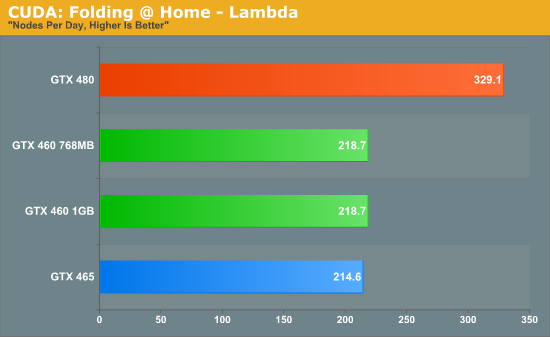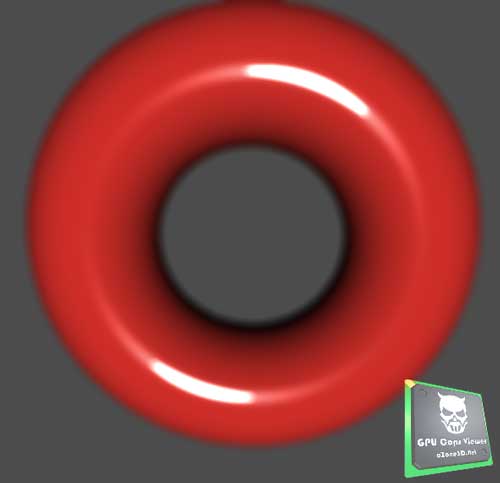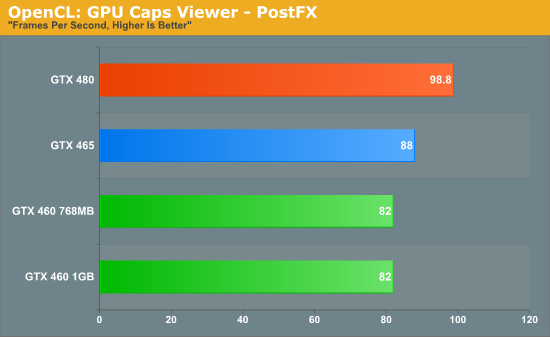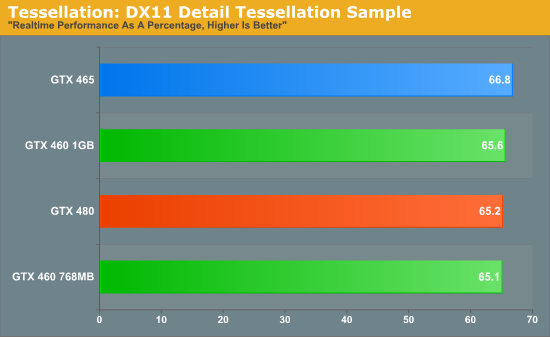NVIDIA’s GeForce GTX 460: The $200 King
by Ryan Smith on July 11, 2010 11:54 PM EST- Posted in
- GPUs
- GeForce GTX 400
- GeForce GTX 460
- NVIDIA
Compute & Tessellation Performance
With our earlier discussion on the GF104’s revised architecture in mind, along with our gaming benchmarks we have also run a selection of compute and tessellation benchmarks specifically to look at the architecture. Due to the fact that NVIDIA added an additional block of CUDA cores to an SM without adding another warp scheduler, the resulting superscalar design requires that the card extract ILP from the warps in order to simultaneously utilize all 3 blocks of CUDA cores.
As a result the range of best case to worst case scenarios is wider on GF104 than it is GF100: while GF100 could virtually always keep 2 warps going and reach peak utilization, GF104 can only reach peak utilization when at least 1 of the warps has an ILP-safe instruction waiting to go, otherwise the 3rd block of CUDA cores is effectively stalled and a GTX 460 performs more like a 224 CUDA core part. Conversely with a total of 4 dispatch units GF104 is capable of exceeding GF100’s efficiency by utilizing 4 of 7 execution blocks in an SM instead of 2 of 6.
Or in other words, GF104 has the possibility of being more or less efficient than GF100.
For our testing we’re utilizing a GTX 480, a GTX 465, and both versions of the GTX 460, the latter in particular to see if the lack of L2 cache or memory bandwidth will have a significant impact on compute performance. Something to keep in mind is that with its higher clockspeed, the GTX 460 has more compute performance on paper than the GTX 465 – 907GFLOPs for the GTX 460, versus 855GFLOPs for the GTX 465. As such the GTX 460 has the potential to win, but only when it can extract enough ILP to keep the 3rd block of CUDA cores working. Otherwise the worst case scenario – every math instruction is dependent – is 605GFLOPs for the GTX 460. Meanwhile the GTX 480 is capable of 1344GFLOPs, which means the GTX 465 and GTX 460 are 63% and 45%-67% as fast as it on paper respectively.

We’ll start with Stanford’s Folding@Home client. Here we’re using the same benchmark version of the client as from our GTX 480 article, running the Lambda work-unit. In this case we almost have a tie between the GTX 460 and the GTX 465, with the two differing by only a few nodes per day. The GTX 465 reaches 65% of the performance of the GTX 480 here, which is actually beyond the theoretical performance difference. In this case it’s likely that the GTX 480 may be held back elsewhere, allowing slower cards to shorten the gap by some degree.
With that in mind the GTX 460 cards achieve 66% of the performance of the GTX 480 here, giving them a slight edge over the GTX 465. Because we’ve seen the GTX 465 pull off better than perfect scaling here it’s very unlikely that the GTX 460 is actually achieving a perfect ILP scenario here, but clearly it must be close. Folding@Home is clearly not L2 cache or memory bandwidth dependent either, as the 768MB version of the GTX 460 does no worse than its 1GB counterpart.

Next up on our list of compute benchmarks is Badaboom, the CUDA-based video encoder. Here we’re measuring the average framerate for the encode of a 2 minute 1080i video cap. Right off the bat we’re seeing dramatically different results than we saw with Folding@Home, with the GTX 460 cards falling well behind the GTX 465. It’s immediately clear here that Badaboom is presenting a sub-optimal scenario for the GTX 460 where the GPU cannot effectively extract much ILP from the program’s warps. At 56% the speed of a GTX 480, this is worse off than what we saw with Folding@Home but is also right in the middle of our best/worst case scenarios – if anything Badaboom is probably very close to average.
Meanwhile this is another program with the lack of memory bandwidth and L2 cache is not affecting the 768MB card in the slightest, as it returns the same 35fps rate as the 1GB card.


Our third and final compute benchmark is the PostFX OpenCL benchmark from GPU Caps Viewer. The PostFX benchmark clearly isn’t solely compute limited on the GTX 400 series, giving us a fairly narrow range of results that are otherwise consistent with the Badaboom. At 82fps, this puts the GTX 460 below the GTX 465 by around 7%, once again showcasing that the superscalar GTX 460 has more trouble achieving its peak efficiency than the more straightforward GTX 465.


Our final benchmark is a quick look at tessellation. As GF104 packed more CUDA cores in to a SM, the GPU has more than half the compute capabilities of GF100 but only a straight 50% the geometry capabilities. Specifically, the GTX 460 has 45% of the geometry capabilities of the GTX 480 after taking in to account the number of active SMs and the clockspeed difference.
With the DirectX 11 Detail Tessellation sample program, we’re primarily looking at whether we can throw a high enough tessellation load at the GPU to overwhelm its tessellation abilities and bring it to its knees. In this case we cannot, as the GTX 460 scales from tessellation factor 7 to tessellation factor 11 by basically the same rate as the GTX 480 and GTX 465. This means that the GTX 460 still has plenty of tessellation power for even this demanding sample, but by the same measure it showcases than the GTX 480 is overbuilt if future games target GTX 460 for tessellation.
All things considered our compute and tessellation results are where we expected them to be. That is to say that the GTX 460’s wider range of best and worst case scenarios will show up in real-world programs, making its performance relative to a GTX 465 strongly application dependent. While the GF104 GPU’s architectural changes seem to be well tuned for gaming needs and leading to the GTX 460 meeting or beating the GTX 465, the same can’t be said for compute. At this point it would be a reasonable assumption that the GTX 465 is going to outperform the GTX 460 in most compute workloads, so the relevance of this for buyers is going to be how often they’re doing compute workloads and whether they can deal with the GTX 465’s lower power efficiency.










93 Comments
View All Comments
DominionSeraph - Tuesday, July 13, 2010 - link
Nvidia hit a wall with the GF100, and there really isn't much demand for greater than 4870 performance so ATi can sit on its 5000 series.Wait till the next expansion of WoW comes out and we might see a push for more.
7Enigma - Tuesday, July 13, 2010 - link
I was going to post exactly this. I also built my gaming rig in Jan 09 with a 4870 that I belive was $180 after a $20 rebate, but it was a Sapphire Toxic (factory OC'd with heatpipe).I was shocked to see how little performance improvement could be had for the same money today. I would have expected at least a minimum of 25% and more like 50% improvement across the board.
And I bought the 4870 when the 4890 was just coming out so it's really 2-2.5 years old tech only slightly being outperformed.
The0ne - Monday, July 12, 2010 - link
I really appreciate the work done on the tests and especially the charts. I'm glad to see my somewhat aging 4870 on the list for comparison. Seems like I'll be handing it over to my nephews in favor of a 5870 soon. Just waiting and hoping for prices to drop in the next month or so. Crossing fingers!Interitus - Monday, July 12, 2010 - link
This is my gripe with the reviews lately. Your aging 4870 is on that list, yet we can't get a 5850 CF number??? Really??? There's even a 3870 in some bench charts..Not like I can't go look it up somewhere else, but it's pretty ridiculous that 5850 CF seems to always be missing. I have one and am considering two. It would be nice to see how 460 1GB SLI fared alongside 5850 CF.
The0ne - Tuesday, July 13, 2010 - link
The issue you've mentioned plagues many, if not ALL, online reviews. I truly cannot understand why they can't or won't include suitable video cards for comparisons. The only difficulty is to maintain the test setups are the same, otherwise keeping the info in a database and updating it is rational. Even with the charts here, some cards are listed and then not listed in other charts.I have 30" screens so I mostly view the highest resolution performance charts but even then I have to resort lower resolutions to find cards I'm interested in. I'm just thankful that if Anand is missing what I need, I can go to other sites and pray to God I can find it there AND be able to make a reasonable comparison (test setups and such differing).
Mr Perfect - Monday, July 12, 2010 - link
I'm glad to see a component review on AT again. Every day for what feels like an eternity now, it's been nothing but cell phones, laptops, pre-built rigs, and all manner of factory assembled consumer electronica. I'm off to read the vendor-specific 460 article now!futurepastnow - Monday, July 12, 2010 - link
Looks like Nvidia should have called it the Geforce HD 3870 ;)Hrel - Monday, July 12, 2010 - link
Why does the 768MB card keep beating the 1GB card?Ryan Smith - Tuesday, July 13, 2010 - link
On which charts are you seeing that?Poisoner - Tuesday, July 13, 2010 - link
This makes me wish I had an nVidia based chipset. I guess 2 4870s will have to do.